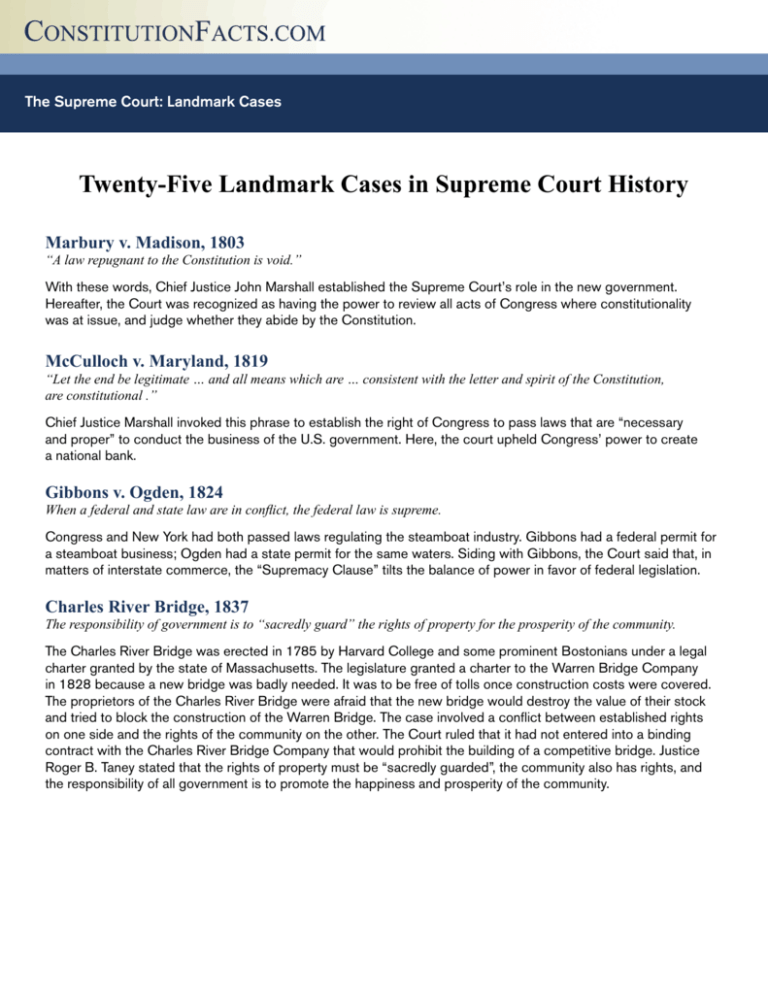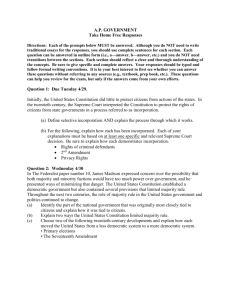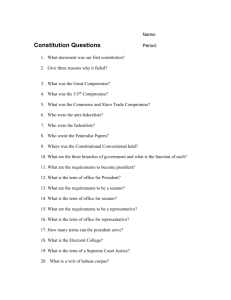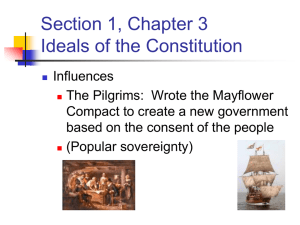
The Supreme Court: Landmark Cases (Continued)
Twenty-Five Landmark Cases in Supreme Court History
Marbury v. Madison, 1803
“A law repugnant to the Constitution is void.”
With these words, Chief Justice John Marshall established the Supreme Court’s role in the new government.
Hereafter, the Court was recognized as having the power to review all acts of Congress where constitutionality
was at issue, and judge whether they abide by the Constitution.
McCulloch v. Maryland, 1819
“Let the end be legitimate … and all means which are … consistent with the letter and spirit of the Constitution,
are constitutional .”
Chief Justice Marshall invoked this phrase to establish the right of Congress to pass laws that are “necessary
and proper” to conduct the business of the U.S. government. Here, the court upheld Congress’ power to create
a national bank.
Gibbons v. Ogden, 1824
When a federal and state law are in conflict, the federal law is supreme.
Congress and New York had both passed laws regulating the steamboat industry. Gibbons had a federal permit for
a steamboat business; Ogden had a state permit for the same waters. Siding with Gibbons, the Court said that, in
matters of interstate commerce, the “Supremacy Clause” tilts the balance of power in favor of federal legislation.
Charles River Bridge, 1837
The responsibility of government is to “sacredly guard” the rights of property for the prosperity of the community.
The Charles River Bridge was erected in 1785 by Harvard College and some prominent Bostonians under a legal
charter granted by the state of Massachusetts. The legislature granted a charter to the Warren Bridge Company
in 1828 because a new bridge was badly needed. It was to be free of tolls once construction costs were covered.
The proprietors of the Charles River Bridge were afraid that the new bridge would destroy the value of their stock
and tried to block the construction of the Warren Bridge. The case involved a conflict between established rights
on one side and the rights of the community on the other. The Court ruled that it had not entered into a binding
contract with the Charles River Bridge Company that would prohibit the building of a competitive bridge. Justice
Roger B. Taney stated that the rights of property must be “sacredly guarded”, the community also has rights, and
the responsibility of all government is to promote the happiness and prosperity of the community.
The Supreme Court: Landmark Cases (Continued)
Dred Scott v. Sandford, 1857
“The Constitution does not consider slaves to be U.S. citizens. Rather, they are constitutionally protected property of
their masters.”
Chief Justice Roger Taney authored this opinion— one of the most important and scorned in the nation’s history. Dred
Scott, a slave, had moved with his master to Illinois, a free state. He moved again to a slave state, Missouri, and filed
suit to gain freedom, under that state’s law of “Once free, always free.” Taney held that Scott had never been free at all,
and cited Constitutional grounds for placing the slavery decision in the hands of the states. In trying to put an end to the
slavery controversy, Taney instead sped the nation toward civil war. The decision was later overturned by the Thirteenth
Amendment.
Munn v. Illinois, 1877
Businesses that serve the public interest are subject to regulation by state government.
The Illinois state legislature passed a law that established the maximum rates that private companies could charge in
storing or transporting agricultural products. In Chicago the company of Munn and Scott was found guilty of breaking
the law and the verdict was upheld on appeal before the Supreme Court. The appeal was heard along with seven other
railroad cases that dealt with the violation of the regulatory legislation passed by the state of Illinois. The Court ruled
that any business that served the public interest was subject to regulation by the state government. If the rates were not
satisfactory according to the owners of the companies, the complaints should be taken to the legislature and not to the
courts.
Plessy v. Ferguson, 1896
Jim Crow laws are constitutional under the doctrine of ‘Separate but Equal.’
Police arrested Homer Plessy for refusing to leave a railroad car that prohibited “colored” people. Under Louisiana law,
Plessy was “colored” because he was one-eighth black. The Court ruled that the race-based “Jim Crow” laws did not
violate the Constitution as long as the states proffered separate but equal treatment.
“The Constitution is color blind, and neither knows nor tolerates classes among citizens.”
—Justice John Marshall Harlan,
from the lone dissenting opinion in Plessy v. Ferguson
Lochner v. New York, 1905
The Constitution bars a state from interfering with an employee’s right to contract with an employer.
The above reasoning led to the “Lochner Era”—thirty-two years of wrangling between the court and legislatures.
Lochner’s bakery violated a New York labor law. The court struck down the law, saying that the 14th Amendment’s
Due Process Clause barred states from regulating commerce in this manner. This clause, the Court said, implied that
individuals have a fundamental right to contract with employers, and states cannot interfere with that right.
2
The Supreme Court: Landmark Cases (Continued)
Schenck v. United States, 1919
Speech that presents a “clear and present danger” to the security of the United States is in violation of the principle of
free speech as protected by the First Amendment to the Constitution.
During World War I (1918), Charles Schenck was the general secretary of the Socialist Party, and was arrested for
distributing literature discouraging young men from enlisting in the armed forces. The basis for his opposition to the
draft or enlistment was the first clause of the Thirteenth Amendment which prohibited slavery or involuntary servitude.
Schenck appealed his conviction and the case went to the Supreme Court. Justice Oliver Wendell Holmes stated that “the
character of every act depends upon the circumstances in which it is done. The most stringent protection of free speech
would not protect a man in falsely shouting fire in a theatre and causing a panic. [The] question in every case is whether
the words used are used in such circumstances and are of such a nature as to create a clear and present danger that they
will bring about the substantive evils that Congress has a right to prevent.” Distributing the literature during peace time
would have been an entirely different matter, but in time of war Schenck’s actions, according to the Court, presented a
“clear and
present danger” to the security of the United States.
Near v. Minnesota, 1931
“The liberty of the press … is safeguarded from invasion by state action.”
Although the First Amendment ensures a free press, until this case, it only protected the press from federal laws, not state
laws. Minnesota shut down J. M. Near’s Saturday Press for publishing vicious antisemitic and racist remarks. In what is
regarded as the landmark free press decision, the Court ruled that a state cannot engage in “prior restraint”; that is, with
rare exceptions, it cannot stop a person from publishing or expressing a thought.
West Coast Hotel v. Parrish, 1937
“The switch in time that saved nine.”
F. D. R. rallied against the Court’s holdings in the Lochner era. The Court struck down New Deal laws, designed to pull
the country out of the Depression, on grounds that they interfered with a worker’s “right to contract.” F. D. R. pledged to
expand the Court and pack it with pro “New Deal” members. In this case, the Court rejected the Lochner era decisions
and said the government could regulate commerce.
Brown v. Board of Education, 1954
“In the field of public education, the doctrine of ‘separate but equal’ has no place.”
This unanimous decision marked the beginning of the end for the “Separate But Equal” era that started with Plessy,
and the start of a new period of American race relations. With Brown, desegregation of public schools began—as did
resistance to it. Ten contentious years later, the Civil Rights Act of 1964 made racial equality a matter of federal law.
3
The Supreme Court: Landmark Cases (Continued)
Mapp v. Ohio, 1961
Evidence that is illegally obtained by the state may not be used against a defendant in court.
Until Mapp, only the federal government was barred from using illegally obtained evidence. So when local police e
ntered Dolly Mapp’s home without a search warrant and arrested her for possessing obscene books, her conviction
initially stood. The Court overturned her conviction, however, and extended the Constitutional rule to apply to the
states and their subdivisions.
“I know it when I see it.”
—Justice Potter Stewart’s definition of obscenity
in Jacobellis v. Ohio, 1964
Baker v. Carr, 1962
“One person, one vote.”
The above phrase was not authored until a year after Baker, but it has its philosophical roots here. In this case, a
group of Tennessee voters sued the state, claiming its voting districts diluted their political power. Until this point,
the Court refused to decide this kind of case, leaving such “political questions” to the states. Baker, however, held
that the states must meet a Constitutional standard for appointment: districts cannot be drawn in such a way that
they violate the Equal Protection clause of the 14th Amendment.
Engel v. Vitale, 1962
Public institutions (i.e., a school system) cannot require prayer.
Lawrence Roth, an avowed atheist, objected that the Long Island, New York School System was forcing his two
children to recite a 22 word prayer at the beginning of the day. There were actually four other parents involved in
the suit against school board president William Vitale, Jr. The Supreme Court ruled that although the prayer was
nonsectarian and noncompulsory, “it is no part the business of government to compose official prayers.” Because
New York provided the prayer, it indirectly approved religion and that was unconstitutional.
Gideon v. Wainwright, 1963
Defendants in criminal cases have an absolute right to counsel.
Too poor to afford a lawyer, Clarence Earl Gideon was convicted for breaking into a poolroom—a felony crime in
Florida. He appealed to the Supreme Court, which ruled that the government must provide free counsel to accused
criminals who cannot pay for it themselves. At first, the ruling applied to felonies only. It was later extended to cover
any cases where the penalty was six months imprisonment or longer.
4
The Supreme Court: Landmark Cases (Continued)
New York Times Co. v. Sullivan, 1964
To win a libel case, public figures must prove “actual malice” on the part of the writer.
In 1964, the Times published an ad critical of an elected commissioner of an Alabama city. The commissioner
sued for libel and won. The Supreme Court overturned that ruling, and said that, to ensure “uninhibited, robust and
wide-open” debate about public figures, the law must protect writers from libel suits. Thus, unless the words are
penned with “knowing falsity” or “reckless disregard for the truth,” a writer cannot be successfully sued by a public
figure for libel.
Griswold v. Connecticut, 1965
The Constitution implies a right to privacy in matters of contraception between married people.
Estelle Griswold, the director of a Planned Parenthood clinic, broke an 1879 Connecticut law banning
contraception. The Court struck down the law, making it a landmark case in which the Court read the Constitution
to protect individual privacy. This was to be the foundation of further privacy rulings, including the right to privacy in
matters of abortion.
Miranda v. Arizona, 1966
“You have the right to remain silent …”
After police questioning, Ernesto Miranda confessed to kidnapping and raping a woman. The Court struck down his
conviction, on grounds that he was not informed of his 5th Amendment right against self-incrimination. Hereafter,
the Miranda warnings have been a standard feature of arrest procedures.
Tinker v. Des Moines, 1969
School dress codes are not in violation of the First Amendment’s guarantee of the freedom of expression.
The Des Moines public school system made a rule stating that any student wearing an armband would be asked
to remove it on the grounds that the wearing of such would cause a disturbance. If the student refused to comply,
the consequence was suspension from school. Three public school students wore black armbands to express their
opposition to the United States’ involvement in the Vietnam War. They refused to remove the armbands and were
suspended. The parents of the students argued that the students’ actions were not interfering with the rights of the
other students. The case was argued in 1968 and the ruling was “handed down” in 1969. The Court ruled that the
wearing of armbands was “closely akin to ‘pure speech’”, and this was protected by the First Amendment to the
Constitution. The rule banning armbands lacked the proper justification for enforcement. This ruling eventually had
an effect on school dress codes in that the style of clothing one wears indicates an expression of that individual.
San Antonio Independent School District v. Rodriguez, 1973
The Constitution does not guarantee a fundamental right to education.
In 1968, a group of low-income parents sued San Antonio, claiming the city’s wealthy precincts had better schools.
The Court upheld the districting plan, saying that the Constitution did not guarantee an education, and upholding
this tenet: The Constitution does not compel government to provide services like education or welfare to the people.
Rather, it places boundaries on government action.
5
The Supreme Court: Landmark Cases (Continued)
Roe v. Wade, 1973
The Constitutionally implied right to privacy protects a woman’s choice in matters of abortion.
Norma McCorvey sought an abortion in Texas, but was denied under state law. The Court struck down that law, on
grounds that it unconstitutionally restricted the woman’s right to choose. The opinion set forth guidelines for state
abortion regulations; states could restrict a woman’s right to choose only in the later stages of the pregnancy. Later
modified but not overruled, the decision stands as one of the Court’s most controversial.
United States v. Nixon, 1974
“Neither separation of powers, nor the need for confidentiality can sustain unqualified Presidential immunity from the
judicial process.”
President Nixon sought precisely this type of immunity, rather than relinquishing the famous White House tapes
during the Watergate scandal. The Court unanimously rejected his plea as an unconstitutional power play. The
House began impeachment proceedings shortly thereafter, and two weeks after the ruling, Nixon resigned.
Texas v. Johnson, 1989
The Constitution protects desecration of the flag as a form of symbolic speech.
Johnson burned a flag in front of a Dallas building in 1984. He was convicted of violating a Texas law that made it a
crime to intentionally desecrate a state or national flag. Justice Brennan wrote for a 5-to-4 majority that “Government
may not prohibit the expression of an idea because society finds the idea itself offensive or disagreeable.”
Cruzan v. Missouri Dept. of Health, 1990
While the Constitution protects a person’s right to reject life-preserving medical treatment (their “right to die”), states can
regulate that interest if the regulation is reasonable.
Nancy Cruzan lay in a permanent vegetative state as a result of injuries suffered in an auto accident. Her parents
sought to withdraw life-sustaining treatment and allow her to die, claiming she’d said this would be her wish under
such circumstances. The state refused, and the Supreme Court upheld the state’s guidelines for the continuation of
medical treatment, which allowed withdrawal of treatment only with clear and convincing evidence that this is what
the patient would have wanted. The Court said that, given the need to protect against abuses of such situations, the
state can continue life support as long as its standards for doing so are reasonable.
To learn more about the Constitution — the people, the events, the landmark cases —
order a copy of “The U.S. Constitution and Fascinating Facts About It” today!
Call to order: 1-800-887-6661 or order online at www.constitutionfacts.com
© Oak Hill Publishing Company. All rights reserved.
Oak Hill Publishing Company. Box 6473, Naperville, IL 60567
6










